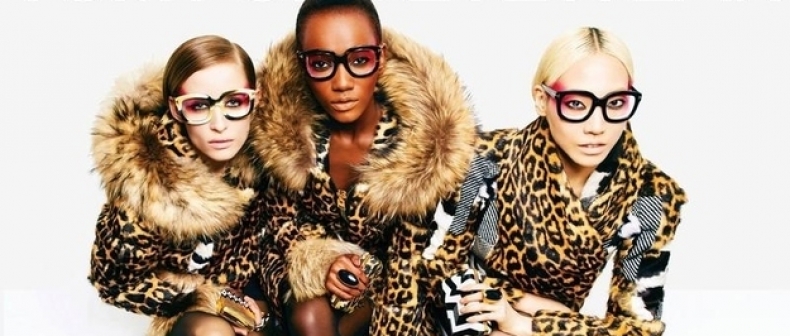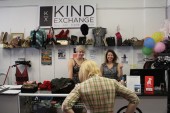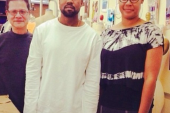
Now that the weather’s consistently warm and we’ve busted out our flip flops, it’s the perfect time for designer labels to launch their fall lines. Prepare for previews of fall trends nestled in July magazines like autumn leaves in a book of pressed flowers. Along with pastel-coloured coats and mid-century Hitchcockian suits, another trend is apparent in fall/winter 2013 designer ad campaigns–an increase in the racial diversity of models.
Ads for Chanel, Dsquared2, and Etro feature groups of Asian models, while black models Joan Smalls (for Hugo Boss) and Malaika Firth (for Prada) have prominent solo campaigns. (Firth is the first black model to pose for Prada since Naomi Campbell 19 years ago.) Roberto Cavalli and Tom Ford both produced ads with a trio of models–one Asian, one black, and one white. Is this the birth of a new fashion ad cliché?
It needs to be said that there are not only three races in the world and the fashion industry still has a long way to go when it comes to celebrating a diversity of ethnicities, cultures, body shapes, ages, and sexual/gender identities. But the fall ad campaigns are a step in the right direction, especially after media commentators roundly criticized the season’s runway presentations (from some of the same labels) for their lack of diversity. The website Jezebel tallied up the numbers–83% of the models at New York Fashion Week were white, a greater percentage than the two seasons before.
What happened between the runway shows last February and the ad campaigns now? While it might be nice to think companies responded to the criticism, I think the change has more to do with the different mediums. Fashion shows are attended mostly by industry insiders, journalists (who report on the trends), and bloggers (who report on the food). Jezebel aside, racial diversity isn’t high up on the list for most editors, stylists, and writers, so why should the runway organizers care either?
In contrast, companies aim ad campaigns right at the consumer. They’re labels’ chance to speak to the customer and summarize what the brand is about before she flips the page. It’s a much better opportunity to support diversity and hire models that resemble the consumer. Models on the runway get lost in a sea of similarly-bodied women, but ads zoom in their individual faces, turning them from walking mannequins to recognizable stars. Would Kate Moss have become a household name without Calvin Klein there to celebrate her unique beauty?
And yet some people aren’t too pleased with the fall ad campaigns, or at least want the celebratory Champagne to remain corked. “Casting only Asian does not make you ‘not-racist,’” one commenter wrote under the Buzzfeed story about the ad campaigns, ignoring Smalls, Firth, and the other black models pictured. “They’re only doing this because Asia has the largest demand for luxury goods,” another added. A third put it thusly, “Don’t be ignorantly celebratory about the inclusion of Asian faces in any non-Asian company ad campaign–doing so is a purely craven ploy to appeal to the increasingly rich Chinese population.”
Chinese consumers, particularly from the ascendant upper middleclass, are dropping yuan like never before. China is the biggest market for luxury goods, and will account for 22% of global luxury sales by 2015. Chinese consumers knowledge of foreign brands has exploded in the last decade, with many becoming more discerning shoppers. Some obviously flashy items have dropped in sales (like Swiss watches), while companies like Burberry continue to expand. As The Economist argues, Western luxury companies will have to continue tailoring their businesses to the Chinese traveller and online shopper (the Internet loads slowly in China, and most websites don’t translate prices into yuan) if they want to stay relevant in this new economy.
Casting Asian models is one way to attract this market. Rather than a “craven ploy” to somehow trick Chinese consumers into buying their products, luxury brands are simply going where their customers are. It’s what they do. Why would they not court Chinese, Japanese, and Korean customers by casting Asian models? It would look offensive if they didn’t.
People have a feeling we should work towards diversity in advertising for humanitarian reasons, because it’s the right thing to do. I agree. As someone who’s suffered from insecurity about my looks, and only saw people who resembled me in fashion media in my adulthood, I understand how powerful it is to see your image reflected back on the pages of glossy magazines. Fashion magazines and luxury goods companies have a responsibility to show different kinds of beauty, but they have failed time and time again.
But that doesn’t mean it’s a bad thing when they have an economic reason for showcasing diversity. Their business is purses, not public service announcements. If you have a problem with a company aiming ads at a customer likely to buy its product, you have a problem with consumer capitalism, not models.
I believe something else is going on here. You can see it in the way commenters basically ignored the fall ad campaigns’ prominent black models (who are a big deal considering the fashion industry’s long coolness towards African American models). Perhaps what’s bugging some people is the lurking feeling the West is no longer the centre of things, that the world’s economy and culture is shifting unalterably towards the East. Asian models may be just the beginning. In the not too distant future, it might be newsworthy when a Beijing fashion house hires a lone white woman for their international ad campaign.
____
Max Mosher writes about style for Toronto Standard. You can follow him on Twitter at @max_mosher_.
For more, follow us on Twitter @TorontoStandard or subscribe to our newsletter.














